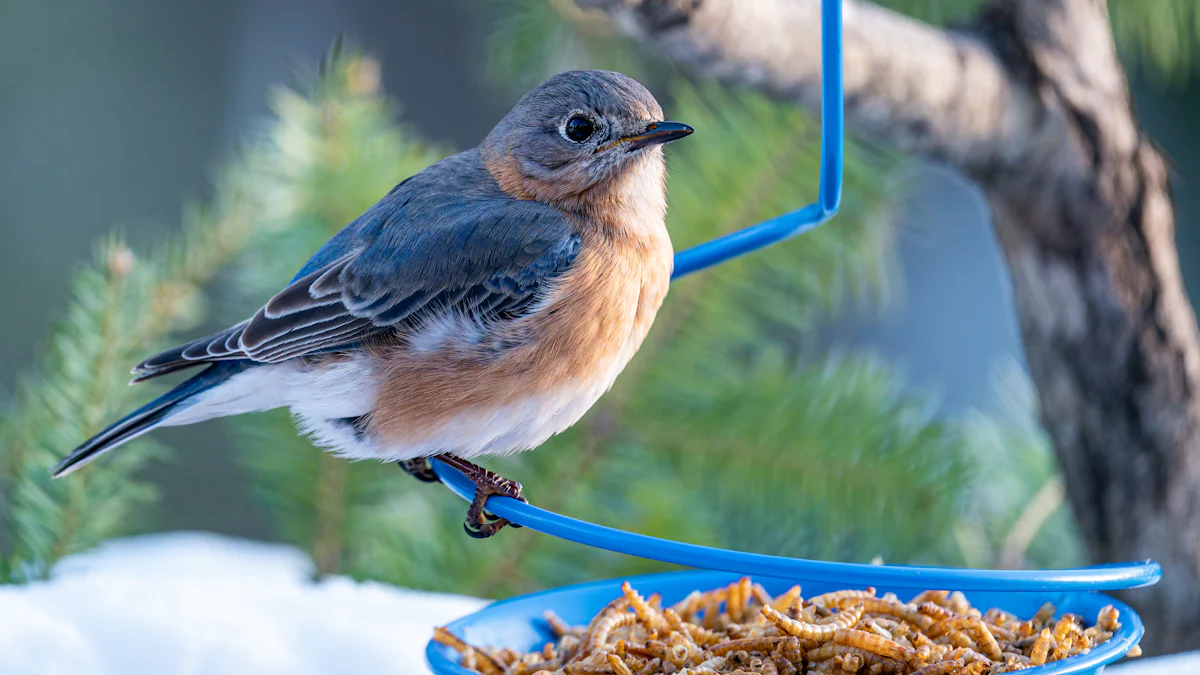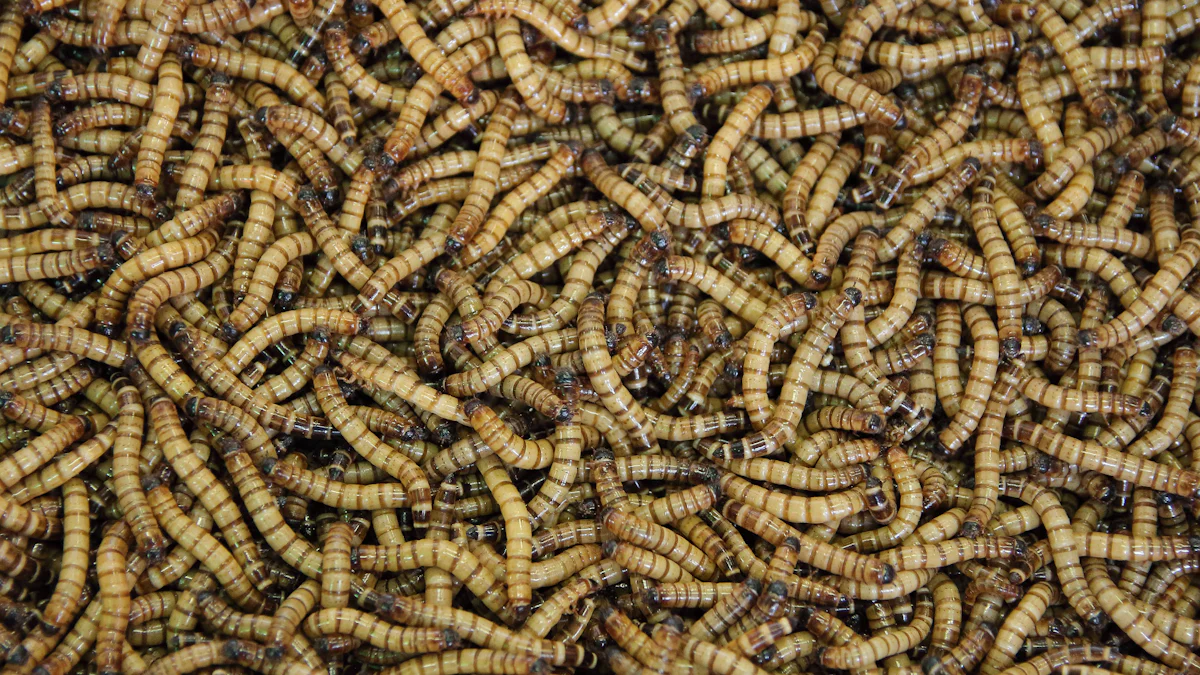
Have you ever wondered how to give your pet a health boost? Dried mealworms for pets might be the answer. Packed with 53% protein, they rival chicken and surpass beef. They’re also loaded with iron, calcium, magnesium, and zinc, which support strong bones and a robust immune system. Plus, their B vitamins and omega-6 fatty acids promote shiny fur and healthy skin.
Key Takeaways
- Dried mealworms have a lot of protein, about 54%. Protein helps pets grow strong muscles and stay healthy.
- They also have important vitamins and minerals like iron, calcium, and zinc. These help pets have strong bones and shiny fur.
- Add dried mealworms slowly to your pet’s food. Start with small amounts to prevent stomach problems and make sure they like it.
Nutritional Benefits of Dried Mealworms
High Protein Content and Its Role in Immunity
When I think about keeping pets healthy, protein is one of the first things that comes to mind. It’s like the building block for their muscles, skin, and even their immune system. Dried mealworms for pets are an incredible source of protein, with up to 54% protein content. That’s higher than most other pet foods, including beef and pork!
Here’s why this matters. Protein helps your pet’s body repair tissues and build strong muscles. It also plays a big role in producing antibodies, which are essential for fighting off illnesses. I’ve noticed that pets fed with high-protein diets tend to stay more active and recover faster from minor injuries or illnesses.
Mealworms also provide B vitamins, like B12 and B2, which help convert food into energy. This keeps pets lively and full of energy. Plus, the protein in mealworms is highly digestible, meaning your pet’s body can absorb and use it efficiently.
Essential Vitamins and Minerals for Immune Support
Dried mealworms for pets aren’t just about protein. They’re packed with essential vitamins and minerals that boost overall health. For example, they’re rich in iron, calcium, magnesium, and zinc. These minerals are crucial for bone health, energy production, and a strong immune system.
Let me share a quick comparison to show how mealworms stack up against other foods:
| Nutrient | Dried Mealworms | Eggs | Pork | Beef | Lamb | Fish | Milk |
|---|---|---|---|---|---|---|---|
| Iron | Higher | Lower | Lower | Lower | Lower | Lower | Lower |
| Zinc | Higher | Lower | Lower | Lower | Lower | Lower | Lower |
| Vitamin E | 4.4x more | 1x | 3.2x | 5.1x | 10.6x | 1.2x | 10.6x |
These nutrients work together to keep your pet’s immune system strong. For instance, zinc supports wound healing, while vitamin E protects cells from damage. I’ve seen firsthand how pets with diets rich in these nutrients have shinier coats and more energy.
Adding dried mealworms to your pet’s diet is a simple way to give them a nutrient boost. Whether it’s for their bones, skin, or immune system, these little worms pack a big punch.
Types of Pets That Benefit from Dried Mealworms

Birds
I’ve noticed that birds absolutely love dried mealworms. They’re like a treat packed with protein and essential nutrients. Robins, for example, actively collect mealworms to feed their nestlings in spring. It’s fascinating to watch them swoop down and grab these tasty morsels. Chickens also benefit greatly. Mealworms give them a protein-rich energy boost, which helps with egg production and keeps them lively. Ducks, canaries, and finches also thrive on mealworms. They enhance feather quality and provide the energy these birds need to stay active.
Here’s a quick look at how different birds benefit:
| Bird Species | Benefits |
|---|---|
| Chickens | Protein-rich energy boost for egg production |
| Ducks | Supports overall health and energy levels |
| Canaries | Enhances feather quality and vitality |
| Finches | Provides essential protein for growth and energy |
While mealworms aren’t a dietary requirement for birds, they’re a fantastic supplement to their varied diets.
Reptiles
Reptiles also enjoy dried mealworms, but I’ve learned they need them in moderation. The drying process alters the nutritional profile, increasing fat content. Overfeeding can lead to obesity. Bearded dragons, leopard geckos, and chameleons benefit the most. Mealworms provide high protein for growth, support healthy skin, and even aid in shedding. I always make sure to balance mealworms with other foods to keep my reptiles healthy.
| Reptile Type | Benefits of Dried Mealworms |
|---|---|
| Bearded Dragons | High protein and essential nutrients for growth |
| Leopard Geckos | Supports healthy skin and shedding |
| Chameleons | Provides energy and aids in overall health |
Small Mammals
Small mammals like hedgehogs, hamsters, and sugar gliders also benefit from dried mealworms. These little critters need protein and minerals like calcium and zinc for strong bones and energy. I’ve seen how much hedgehogs enjoy mealworms as a snack. It’s a great way to add variety to their diet while keeping them healthy and active.
Dried mealworms for pets are truly versatile. Whether you have birds, reptiles, or small mammals, they’re a nutrient-packed addition to your pet’s diet.
How to Safely Feed Dried Mealworms to Your Pets
Recommended Serving Sizes
When it comes to feeding dried mealworms to pets, portion control is key. I always keep in mind that the size and dietary needs of my pet determine how much to serve. For smaller pets, like hamsters or finches, just a few mealworms per feeding is enough. Larger pets, such as chickens or bearded dragons, can handle a slightly bigger portion.
Typically, I feed dried mealworms 1-2 times a week. This schedule works well for most pets. However, pets with higher protein needs, like growing reptiles or egg-laying birds, might benefit from more frequent servings. Overfeeding can lead to dietary imbalances, so I always stick to moderation.
Tips for Introducing Mealworms into Your Pet’s Diet
Introducing dried mealworms to a pet’s diet can be a fun process. I’ve found that soaking the mealworms in warm water for 10-15 minutes makes them softer and easier to chew. After soaking, I drain the water and serve them fresh. This little trick works wonders, especially for pets trying mealworms for the first time.
Another tip is to mix mealworms with their regular food. This helps pets get used to the new taste. I also use mealworms as treats during training sessions. It’s a great way to encourage acceptance. While doing this, I always monitor my pet’s reaction to ensure they’re adjusting well.
Potential Risks and How to Avoid Them
Feeding dried mealworms to pets is generally safe, but there are a few things to watch out for. Gradual introduction is important to avoid digestive upset or allergic reactions. I start with small amounts and increase gradually. Chitin, a component in mealworms, can sometimes trigger allergies in pets, though this is rare. If I notice any unusual symptoms, I stop feeding them immediately and consult a vet.
Portion control is another critical factor. Mealworms are nutrient-dense, so overfeeding can lead to obesity or other health issues. By sticking to recommended serving sizes, I ensure my pets stay healthy and happy.
Dried mealworms for pets are a fantastic addition to their diet when fed safely and in moderation. With these tips, you can make sure your pets enjoy all the benefits without any risks.
Dried Mealworms for Pets are a powerhouse of nutrition. They’re packed with protein, iron, calcium, and zinc, which support immunity and bone health. Birds, reptiles, and small mammals thrive on them. Their long shelf life and versatility make them a safe, convenient choice. Feed them in moderation, and your pet’s health will flourish.
FAQ
What makes dried mealworms so nutritious?
Mealworms are packed with protein, iron, calcium, magnesium, and zinc. These minerals support bone health, energy production, and a strong immune system. They’re a tiny powerhouse of nutrients!
Can I feed dried mealworms to my puppy or kitten?
No, dried mealworms aren’t suitable for puppies or kittens. They’re better for birds, reptiles, and small mammals. Always check your pet’s dietary needs before introducing new foods.
How should I store dried mealworms?
I keep them in an airtight container in a cool, dry place. This prevents moisture and keeps them fresh for months. Proper storage ensures your pet gets the best quality.


